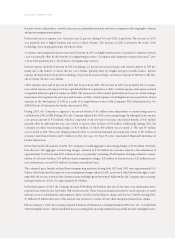American Express 2003 Annual Report Download - page 39
Download and view the complete annual report
Please find page 39 of the 2003 American Express annual report below. You can navigate through the pages in the report by either clicking on the pages listed below, or by using the keyword search tool below to find specific information within the annual report.
at AEFA and fewer sales of cardmember receivables and loans to TRS’ securitization trusts. The Company also invested in
two acquisitions, Threadneedle and Rosenbluth, increasing the net cash used in investing activities.
The increase in investing activities in 2002 as compared to 2001 also relates to increases in investments and cardmember
receivables and loans.
Cash Flows from Financing Activities
The Company’s financing activities primarily include the issuance of debt and AEFA’s sale of annuities and investment cer-
tificates, in addition to taking customer deposits. The Company also regularly repurchases its common shares.
Net cash provided by financing activities for the year ended December 31, 2003 was greater than 2002, primarily due to a
net increase in total debt compared to a net decrease in 2002.
In 2002, financing activities provided net cash while in 2001 net cash was used in financing activities, primarily due to a
net decrease in debt.
Share Repurchases
As discussed previously, the Company has in place a share repurchase program to return equity capital in excess of its busi-
ness needs to shareholders. These share repurchases both offset the issuance of new shares as part of employee compensa-
tion plans and reduce shares outstanding.
The Company repurchases its common shares primarily by open market purchases using several brokers at competitive
commission and fee rates. In addition, common shares may also be purchased from the Company-sponsored Incentive Sav-
ings Program (ISP) to facilitate the ISP’s required disposal of shares when employee-directed activity results in an excess
common share position. Such purchases are made at market price without commissions or other fees. Repurchases were
also accomplished by cash prepayments under the Company’s agreements with third parties, which are described below.
During 2003, the Company repurchased 36 million common shares at an average price of $38. Since the inception of the
current share repurchase program, 426 million shares have been acquired at an average price of $26 under authorizations
to repurchase up to 570 million shares, including purchases made under the agreements with third parties. Included in the
2003 repurchase amount are 15 million shares delivered to the Company as part of the prepayments discussed below.
In August 1999 and March 2000, the Company entered into agreements under which a financial institution purchased an
aggregate 29.5 million of the Company’s common shares at an average purchase price of $50.41 per share. These agreements
were entered into to partially offset the Company’s exposure to the effect on diluted earnings per share of outstanding in-
the-money stock options issued under the Company’s stock option program. The agreements provided that upon their ter-
mination, the Company would be required to deliver an amount equal to the original purchase price for the shares less any
prepayments. During 2003 and 2002, the Company elected to prepay $535 million and $600 million, respectively, of the
aggregate outstanding amount. The 2003 prepayment amount includes $335 million related to the final payment and ter-
mination of the agreements.
Financing Activities
The Company is committed to maintaining cost-effective, well-diversified funding programs to support current and future
asset growth in its global businesses. Its funding plan is structured to meet expected and changing business needs to fund
asset balances efficiently and cost-effectively through diversified sources of financing, to ensure the availability of financing
in unexpected but foreseeable periods of stress, and to be concurrently integrated into the asset-liability management of
interest rate exposures. Liquidity refers to the Company’s ability to meet its current and future cash needs. In addition to
its funding plan described below, the Company’s contingent funding strategy is designed to allow for the continued fund-
ing of business operations through difficult economic, financial market and business conditions when access to its regular
funding sources could become diminished or interrupted.
(p.37_axp_ financial review)
























